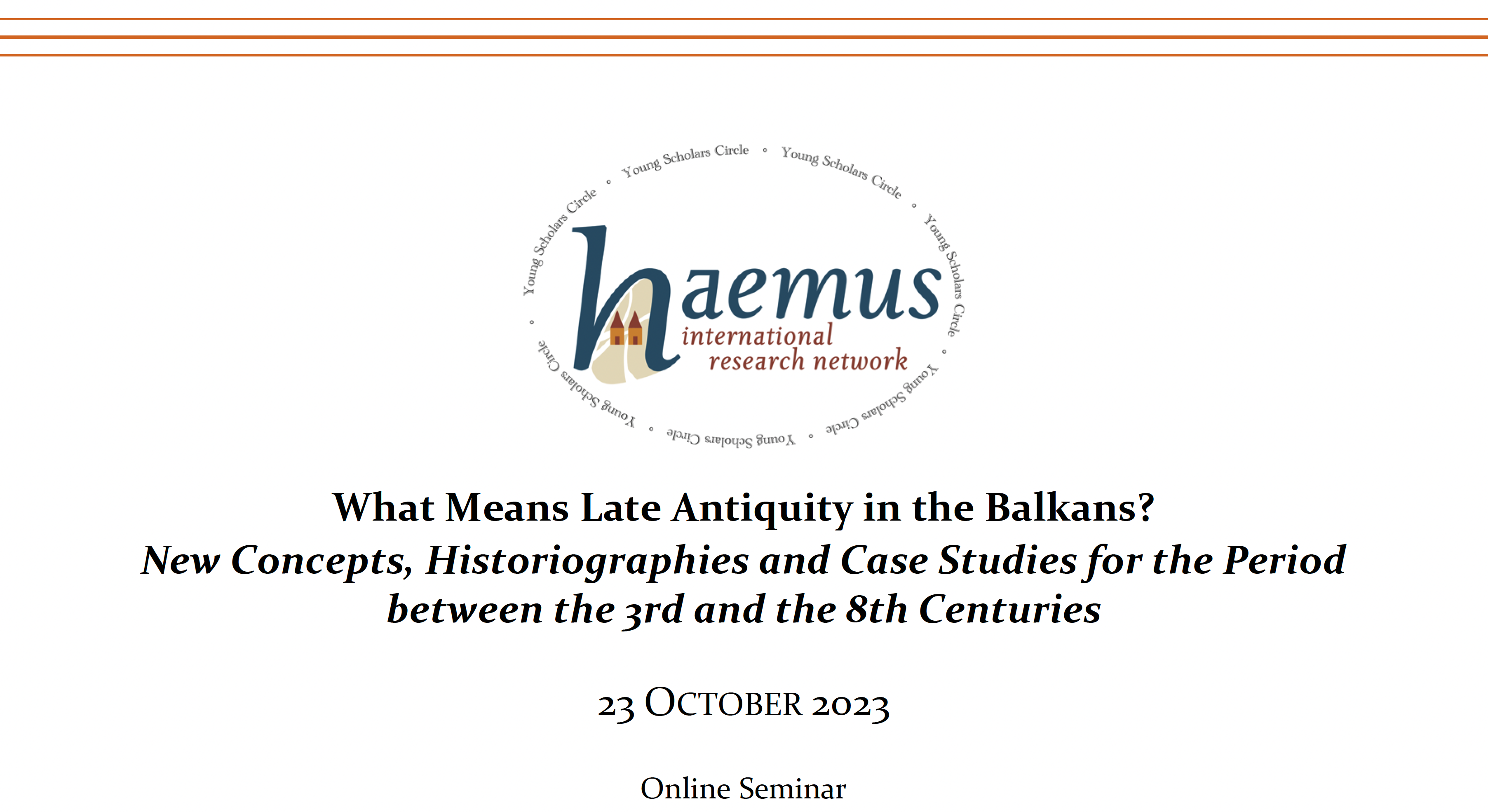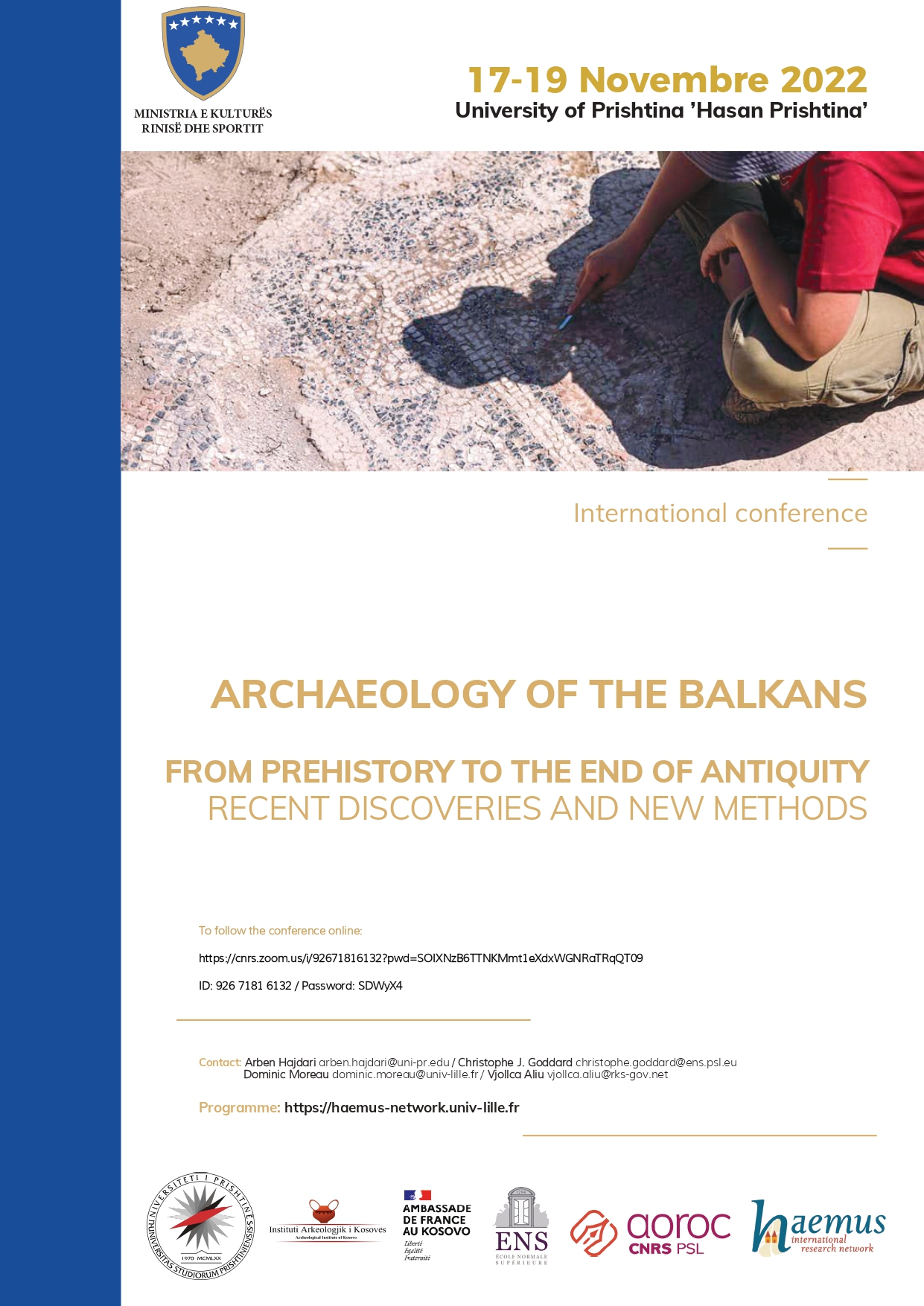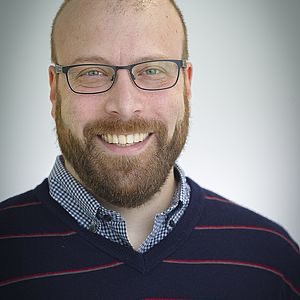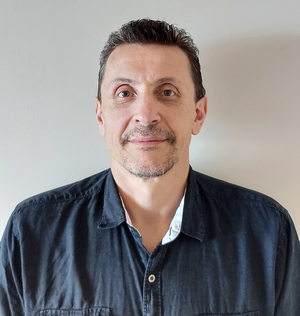What Means Late Antiquity in the Balkans? New Concepts, Historiographies and Case Studies for the Period between the 3rd and the 8th Centuries. 1st Seminar of the HAEMUS Young Scholars Circle (Online, 23 October 2023)
Online Seminar for PhD students and postdocs, organised by the members of HAEMUS YCS Scientific Advisory Board.
To follow the conference online: https://us02web.zoom.us/webinar/register/WN_6N_xLhZ0SPWxaSn3JRXxLQ#/registration
To download the programme.

Peristyle Buildings in Late Antiquity: Architecture, Landscape and Function. International Workshop of the MASLAP Project (Pécs, Hungary, and Online, 7-8 Septembre 2023)
International Workshop organised by Orsolya Heinrich-Tamáska (Leibniz-Institut für Geschichte und Kultur des östlichen Europa/Leibniz-Institute for the History and Culture of Eastern Europe – GWZO and Visiting Professor at the University of Lille), Máté Szabó (Régészeti Intézet/Institute of Archaeology of the Bölcsészettudományi Kutatóközpont/Research Center for Humanities [Centre of Excellence, Hungarian Academy of Sciences], former postdoc of the MASLAP Project), Márton Szabó (PhD Student at the University of Lille for the MASLAP Project) and Friderika Horváth (Régészeti Intézet/Institute of Archaeology of the Bölcsészettudományi Kutatóközpont/Research Center for Humanities [Centre of Excellence, Hungarian Academy of Sciences]), in collaboration with Dominic Moreau (University of Lille/HALMA-UMR 8164 Research Centre), at the Csontváry Múzeum of the Janus Pannonius Múzeum in Pécs and Online, with the support of the HAEMUS International Research Network.
To register, please contact Orsolya Heinrich-Tamáska: orsolya.heinrich-tamaska@leibniz-gwzo.de.
To download the programme.
Post on the creation of the HAEMUS IRN published on the Hypotheses academic blog À l'École de toute l'Italie – Chronique de la vie scientifique de l'École française de Rome
To read the post.
Les églises tétraconques dans l’Antiquité tardive – Le chiese tetraconche nella Tarda Antichità – The Tetraconch Churches in Late Antiquity. Final symposium of the ANR (French National Research Agency)-funded phase of the DANUBIUS Project (Rome, Italy, and Online, 28-29 November 2022)
International symposium organised by Dominic Moreau (University of Lille/HALMA-UMR 8164 Research Centre and Visiting Scholar at the École française de Rome), Irina Achim (Institute of Archaeology „Vasile Pârvan”) and Gabriele Castiglia (Pontificio Istituto di Archeologia Cristiana), under the patronage of the University of Lille and HALMA-UMR 8164 Research Centre (Univ. Lille, CNRS, French Ministry of Culture), in collaboration with the École française de Rome, the Accademia di Romania in Rome and the Pontificio Istituto di Archeologia Cristiana, with the support of the DANUBIUS Project (ANR-French National Research Agency), the HAEMUS International Research Network (“Internationalisation" programme of the University of Lille) and the Université du Québec à Rimouski (Social Sciences and Humanities Research Council of Canada).
To register
To download the programme

Archaeology of the Balkans from Prehistory to the End of Antiquity: Recent Discoveries and New Methods. International Conference (Prishtina, Kosovo, and Online, 17-19 November 2022)
International conference organised by Arben Hajdari (University of Prishtina ’Hasan Prishtina’) and Christophe J. Goddard (CNRS/AOrOc-UMR 8546 Research Centre), in collaboration with Dominic Moreau (University of Lille/HALMA-UMR 8164 Research Centre and Visiting Scholar at the École française de Rome) and Vjollca Aliu (Ministry of Culture, Youth and Sport of Kovoso), with the support of the Ministry of Culture, Youth and Sport of Kovoso, in collaboration with the University of Prishtina ’Hasan Prishtina’, the Archeological Institute of Kosovo, the French Embassy in Kosovo, the École normale supérieure in Paris, the AOrOc-UMR 8546 research centre and the HAEMUS International Research Network.
To follow the conference online: https://cnrs.zoom.us/i/92671816132?pwd=SOIXNzB6TTNKMmt1eXdxWGNRaTRqQT09
ID: 926 7181 6132 / Password: SDWyX4
To download the programme.

Late Antique Elites of the Countryside in the Middle and Lower Danube Provinces. Workshop of the MASLAP Project (Budapest, Hungary, and Online, 28 October 2022)
Workshop organised by Orsolya Heinrich-Tamáska (Leibniz-Institut für Geschichte und Kultur des östlichen Europa/Leibniz-Institute for the History and Culture of Eastern Europe – GWZO and Visiting Professor at the University of Lille) and Máté Szabó (postdoc of the MASLAP Project), in collaboration with Dominic Moreau (University of Lille/HALMA-UMR 8164 Research Centre and Visiting Scholar at the École française de Rome), at the Régészeti Intézet/Institute of Archaeology of the Bölcsészettudományi Kutatóközpont/Research Center for Humanities in Budapest and Online, with the support of the HAEMUS International Research Network.
To register, please contact Máté Szabó: legipek@gmail.com.
To download the programme.
Roman Archaeology Conference 2020/22 (Split, Croatia, 6-8 April 2022) – initially planned on 16-18 April 2020, then in April 2021
Session: From the Roman to the Late Antique Balkans: Changes in the Topography, Form and Function of “Illyrian” and “Thracian” Cities between East and West
Chairs: Dominic Moreau (Lille) and Christophe J. Goddard (Paris)
Abstract: The founding works of A.H.M. Jones, C. Lepelley and J.H.W.G. Liebeschuetz on cities in Late Antiquity have shown that their so-called decline and fall, defended by Fustel de Coulanges, were rather corresponding to profound changes in terms of topography, forms and functions, than to an actual disappearance. It is undeniable that the Roman classical model one day ceased to be, but it was not by leaving room for nothingness. There was indeed a lively world of Late Antique and Early Medieval cities. The last centuries of Antiquity even saw the foundation of new cities, some of them having never been anything but Christian cities. Given the magnitude of the impact of the great invasions/migrations in this region, the three dioceses of Illyricum, Dacia and Thrace were among those, in the Late Roman World, which saw their civic system most shaken by wars and population movements between the third and the eighth centuries. This session proposes to re-evaluate and to illustrate this historical issue in the light of archaeological discoveries of an overlooked region, especially with regard to the spread of Christinianity, by taking a look at the provinces that covered, in Late Roman times, the northern part of the Balkans.
To download the programme.
Website of the congress: www.romansocietyrac.ac.uk
Mention of the creation of the HAEMUS IRN in the 2021 annual report of the Österreichisches Archäologisches institut
To read the report (p. 203).
Webpage of the HAEMUS IRN on the website of the École française d'Athènes
To the webpage.
Interview with Dominic Moreau about the HAEMUS IRN, made on the 21st of April 2021 within a public presentation of the achievements and results of the I-SITE ULNE Foundation
To watch the interview.
Joint Interview with Dominic Moreau and Cristian Găzdac, made on the 16th of March 2021 by Arelis Ardiles for the InclusU: The European University for Inclusiveness project
The interview
1. Can you tell us about PRAE-HAEMUS, as well as HAEMUS, and tell us why both projects are a crucial challenge of our times?
D.M. Thank you for your invitation! For its implementation phase, the project is called PRAE-HAEMUS, and it is simultaneously funded by the I-SITE ULNE Foundation (call for projects “Réseaux internationaux 2021”) and by the University of Lille (call for projects “Internationalisation 2021”). This pre-project aims to lay the groundwork for the HAEMUS International Research Network (https://haemus-network.univ-lille.fr), which will be a very large network of archaeologists and historians from all around the world, working on the 13 countries of South-Eastern Europe which were part of the Roman Empire in Late Antiquity. For now, the project is supported by a consortium of 13 high-ranking European institutions. Ultimately, the entire Balkan peninsula will fully participate in the administration and life of the network, as a scientific board including its top-level academic institutions is in the process of being set up and it will be the real decision-making body. In any case, we don’t want at all to make this experience an unbalanced relationship between the different partners.
Most of the Balkans are now part of the European Union and the few that are not being all candidates. For this reason, all the representatives of the supporting institutions of the network, which form its core group, believe that this is the perfect time to create an international research network for the Late Antique Balkans, in order to promote sharing of data, people, experiences and specialities among all these countries, and to produce cross-referring “eastern-western” research.
The enthusiasm around HAEMUS – to date, 28 international archaeological missions and more than 150 individual researchers have indicated their interest in participating – is indeed the proof that the scientific community is ready to participate in such a network. This community will participate, in its own way, in the “construction” of Europe and its consolidation by facilitating even more exchanges, not only between scholars and students from South-Eastern Europe, but also between them and researchers from all over the world. When Christophe J. Goddard (CNRS, AOrOc-8546, Paris), who is mainly working in Kosovo, and I started working on this idea, as well as gathering people around it, we were relying on the fact that unfortunately the current archaeological and historical research in the region too often remained confined to the borders of contemporary nation states, a bit like the relations that many of the Balkan states have with each other.
C.G. Thank you also for the invitation! I completely agree with Dominic, especially about the fact that scholars from the Balkans need to collaborate even more among themselves, as well as with their foreign colleagues. I was fortunate enough to do my doctoral studies in the UK, which opened up a lot of research horizons for me. At the same time, I had the advantage, for the dissertation topic that I had chosen, of being able to cope in all the languages necessary for the success of my project (Romanian and Hungarian, as well as Serbian and Bulgarian). The fact that the inhabitants of the Balkans are in continuous contact with a very large number of languages in a limited space is indeed a real richness and this is also what I liked about the network project, namely the international highlight of the cultural heritage of South-Eastern Europe, as well as the focus on local realities as a fundamental approach to understanding the past. For sure, you cannot work on the heritage of a Balkan country, even its Roman heritage, without having some knowledge of its language, as you will at one time or another need to consult the bibliography produced locally. This is really a peculiarity of Central and Eastern Europe: we have a very important historiographical tradition in our respective languages.
D.M. If Cristian allows me, I would even add that it is almost a shame that, in Western Europe or North America, we are not, collectively, fully aware of the existence of this important academic literature, as much among archaeologists as historians. Even though the Berlin Wall fell 32 years ago, we can say that in 2021 we are still living with the legacy of the Iron Curtain. For this reason, some colleagues still only see the Roman Empire through its Western part, in particular the Roman province(s) corresponding to the national territory of their own country (Gaul for France, etc.) or that of its former colony. Many are not aware at all of the importance of the Balkans for the Later Roman Empire. Thus, the political situation in the 1900s, especially after the Second World War, but not only, made most of the Balkans a less known research area than other parts of the Roman Empire, in the so-called Western world. This is why it is even more important to read the research results obtained by local researchers.
In the current favourable political context, the supporters of this project are thus defending the necessity of fully sharing and exchanging about the Late Antique Balkans through the existence of an international research network. One of its hopes is to put the Balkans back at the centre of the history of the Later Roman Empire, which is its true place. However, we also want to take this opportunity to go beyond the conventions. For this reason, we have chosen the 8th century as the end date of Antiquity, which is not at all conventional for the region, and we wish to involve in our work specialists from the neighbouring countries of the Balkan Peninsula, in order not to study it in a vacuum and to understand its relations with the rest of the Roman world.
2. What is your experience in the field of archaeology and history of the Late Antique Balkans both at the University of Lille and at Babeș-Bolyai University?
D.M. In France, the University of Lille is one of the few universities that have a long tradition of archaeological work in the Balkans, and in various locations. For a long time now, it has been involved in some of the “traditional” parts of the Balkans involving French teams in Greek and Roman archaeology in Northern Greece (including Thasos) and Albania. Furthermore, Lille was present at the very beginning of the most famous French-Yugoslavian collaboration, more precisely from 1973 to 1975, on the Late Antique site of Sirmium, which is now in Serbia. To this, we can add that it was also involved for decades in Romania, but for prehistory, while being now part of projects in the same field in Hungary. For the University of Lille, the HAEMUS network thus represents a way to continue the work between the past, the present and the future.
When I arrived in Lille in 2014, I proposed my projects in Bulgaria to my research centre, and I was very impressed with how its authorities showed an immediate interest and supported them financially and institutionally. Thanks to this positive experience, I developed an ambitious research programme and created my own network around my research topic, which is helping me now to create and launch the HAEMUS network.
C.G. Having been a student and working now in Romania, my own experience is, of course, a little different from Dominic’s. To sum up, Babeș-Bolyai University is one of the most involved Romanian universities in the field of archaeology in Romania. However, like most universities from the Balkan area, we don’t have a great tradition of working on archaeology outside the national territory. So, we have a lot to bring to the network, as we are one of the major research institutions in archaeology and ancient history north of the Balkans, but also have a lot to gain from this collaboration, in the matter of sharing with the research institutions from other Balkan countries and beyond. The keyword at the centre of the network is really “sharing” – “sharing” in order to teach and to exchange, but to learn from others.
3. What is the added value of doing transnational research cooperation on this project?
D.M. Cristian has already given a part of the answer to this question. Therefore, the power of this network is that it will invite a lot of people who have never exchanged or shared before. In this spirit, no distinction is made between researchers and students working outside Europe and those working on our continent. The idea is to bring together the skills, to offer the best possible job and results. Just to give an example, North American or Australian archaeologists and historians working on the Late Roman world have developed, over time, expertise and methodologies stimulated by their remoteness from the European continent and this can lead to very stimulating and productive dynamics when they are put in relation to more “European” approaches, if I may use this expression. This network therefore also aims to intersect approaches, by giving to everyone the opportunity to exchange and discuss about a common topic.
C.G. Sometimes, in Europe, we indeed have to remind people that the current political borders or national cultures are not necessarily relevant for the study of the Roman world. It spanned over three continents, and, because of its very long-term impact, its history belongs to all of humanity. The HAEMUS network will thus allow researchers to transcend political and national boundaries, in order to enrich exchanges between countries and cultures around a research topic, while highlighting its importance. The main objective is to help people work together in Europe and beyond. So the main added value is to have different people working together, in order to provoke an “inside-outside” exchange – “inside-outside” the Balkans, “inside-outside” Europe.
D.M. And this, not only in science, but also in human terms! Just to give a quick example, when you do archaeological excavations in a foreign country, if you want it to be a real success, you should not only be there to do your task, but also to meet people in their cultural environment. You have to be interested in their language, food, music, ideas, etc. Only in this way can you make your experience completely satisfactory! How can we make human and social sciences without a human and social dimension? This is one of the reasons why this network is important, and let’s hope that it will also help scholars and students in this way.
C.G. As we are talking of added values of the network, I will share my experience to illustrate another one: as a student, I was first thinking of becoming a mediaeval historian, but one of the best Romanian professors in archaeology showed me the way to it. How? Not only by sharing his passion in courses, but also by involving me very soon in fieldwork. Consequently, I decided to devote the rest of my studies to this discipline. In the same way, I was encouraged by my Romanian mentors to specialise in numismatics, because there was then a lack of specialists in this field at Babeș-Bolyai, and to go to study in the UK, in order to get international experience. Why am I telling you this? Because I think that academic contact with world famous specialists in their respective fields is essential for students, and I see our network also as a means of bringing t0gether people who might not have come into contact otherwise. HAEMUS can strongly participate in the training and professional orientation of students, as well as to offer them excellent opportunities abroad. It is really an excellent opportunity to create not only links, but also vocations.
For the next generations of scholars from the Balkans, the creation of such connections around the world will be more than a benefit, not only by learning new techniques, but also by opening them up even more to others. Thus, I hope, it will help to make them even more proud of their cultural heritage and to convince them to defend it even more. The Roman heritage is particularly important in the Balkans. Unfortunately, there are still too many people in the peninsula, even some fully integrated in the cultural institutions, who are illegally selling archaeological artefacts or destroying sites, or by completely catastrophic and unproductive reconstitutions, supposedly for tourism, or by simple destruction, most often because of greed for land. As a government expert on the subject, I thus developed a new research area at Babeș-Bolyai University, relying, in part, on my experience abroad: the protection of cultural heritage.
5. What are the next steps?
D.M. For the upcoming activities, we can say, at this stage, that next June the network will officially launch its cycle of periodic online lectures given by special guests, which will be preceded by a full public presentation of the network. Moreover, the first workshop is scheduled next November. The exact dates and programmes will be announced in the coming weeks.
The workshop, like all the others which will be organised in the future under the aegis of HAEMUS, will become a reference book which will be published by Brepols, in the RomA series, through a special partnership. Alongside the 13 sponsoring institutions, the network is maintaining privileged links not only with this publishing house, but also with the I-SITE ULNE Foundation, the Hauts-de-France region and, of course, the InclusU: The European University for Inclusiveness project, in which Babeș-Bolyai participates.
Aside from these activities, an application to a major funding programme is currently under preparation.
 Dominic Moreau is Maître de conférences (Assoc. Prof.) in Late Antiquity at the Faculty of Humanities of the University of Lille and a permanent member of the HALMA-UMR 8164 research centre (Univ. Lille, CNRS, MC). He first graduated in Canada, from Laval University in Quebec (B.A. and M.A. in Ancient Studies, with a specialisation in History and Epigraphy of Hellenistic and Roman Anatolia), and then in France, from the universities Marc Bloch–Strasbourg II and Paris-Sorbonne (respectively D.E.A. in Sciences of Antiquity and PhD in Civilisation of Late Antiquity and the History of Ancient Christianity, with a dissertation on the temporal action of the Bishop of Rome in the 5th and 6th centuries). He currently focuses his research on the Late Antique Eastern Balkans. Since 2018, he is co-director of the International Archaeological Mission at Zaldapa (Krushari, Bulgaria), as well as Principal Investigator of the
Dominic Moreau is Maître de conférences (Assoc. Prof.) in Late Antiquity at the Faculty of Humanities of the University of Lille and a permanent member of the HALMA-UMR 8164 research centre (Univ. Lille, CNRS, MC). He first graduated in Canada, from Laval University in Quebec (B.A. and M.A. in Ancient Studies, with a specialisation in History and Epigraphy of Hellenistic and Roman Anatolia), and then in France, from the universities Marc Bloch–Strasbourg II and Paris-Sorbonne (respectively D.E.A. in Sciences of Antiquity and PhD in Civilisation of Late Antiquity and the History of Ancient Christianity, with a dissertation on the temporal action of the Bishop of Rome in the 5th and 6th centuries). He currently focuses his research on the Late Antique Eastern Balkans. Since 2018, he is co-director of the International Archaeological Mission at Zaldapa (Krushari, Bulgaria), as well as Principal Investigator of the  Cristian Gazdac is Conferențiar universitar doctor habilitat (Assoc. Prof. Habil.) at the Faculty of History and Philosophy of Babeș-Bolyai University of Cluj-Napoca (Romania), focusing his teaching on Roman Economy and Numismatics, Security Systems in World History, Protection of Cultural Heritage. He graduated from Babeș-Bolyai University (B.A. in History and Philosophy, and M.A. in Classical Antiquity, with a specialisation in numismatics) and from Oxford University (PhD in Ancient History, with a dissertation on coin circulation in Roman and post-Roman Dacia and the adjacent provinces from the Middle and Lower Danube). Being already an Associate Professor at Babeș-Bolyai University, he got his habilitation from this institution in 2014. The main direction of his research has been to establish the monetary policies in Dacia and in the North-Eastern Balkans at a critical moment in the history of the Roman Empire. To this end, he created the
Cristian Gazdac is Conferențiar universitar doctor habilitat (Assoc. Prof. Habil.) at the Faculty of History and Philosophy of Babeș-Bolyai University of Cluj-Napoca (Romania), focusing his teaching on Roman Economy and Numismatics, Security Systems in World History, Protection of Cultural Heritage. He graduated from Babeș-Bolyai University (B.A. in History and Philosophy, and M.A. in Classical Antiquity, with a specialisation in numismatics) and from Oxford University (PhD in Ancient History, with a dissertation on coin circulation in Roman and post-Roman Dacia and the adjacent provinces from the Middle and Lower Danube). Being already an Associate Professor at Babeș-Bolyai University, he got his habilitation from this institution in 2014. The main direction of his research has been to establish the monetary policies in Dacia and in the North-Eastern Balkans at a critical moment in the history of the Roman Empire. To this end, he created the